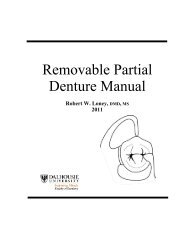Manuals_files/CD Manual 12.pdf - Removable Prosthodontics
Manuals_files/CD Manual 12.pdf - Removable Prosthodontics
Manuals_files/CD Manual 12.pdf - Removable Prosthodontics
You also want an ePaper? Increase the reach of your titles
YUMPU automatically turns print PDFs into web optimized ePapers that Google loves.
Tissue Conditioning - 14<br />
Placement of Temporary Resilient Liners (Tissue Conditioners)<br />
Tissue conditioners provide one of the easiest means of improving the health of the<br />
denture foundation tissues. These materials are also one of the most abused in the dental<br />
office. It is often presumed that the mere presence of a temporary resilient liner will resolve<br />
any mucosal problem. This section outlines a technique that can be used to reduce soft liner<br />
adjustment time, while improving patient comfort and liner longevity. The technique<br />
described has been used with tissue conditioners such as Lynal (Dentsply International Inc.,<br />
Milford, DE), Visco-gel (Dentsply Ltd, Detrey Division, Surrey, England), and Tru-Soft<br />
(Harry J. Bosworth Co., Skokey, IL), but it can be adapted to most other materials that are<br />
available in similar powder/liquid formulations.<br />
Technique:<br />
1. Clean the denture prior to application of the soft liner. Use scalers, pumice on a wet<br />
ragwheel, and an ultrasonic cleaner to eliminate gross debris and calculus. Disinfect the<br />
denture by immersion in sodium hypochoride for at least 10 minutes prior to placement<br />
of the liner. This will help to minimize the presence of microbes, which might<br />
subsequently colonize the liner, thereby shortening liner lifespan. When relining<br />
opposing dentures, reline the least stable denture first so that the more stable denture can<br />
be used as reference for positioning the relined denture, using the occlusal contacts.<br />
2. Determine if the denture base needs to be reduced prior to the placement of the liner.<br />
Flanges that are excessively long or areas that are causing severe inflammation or frank<br />
ulceration should be reduced. The entire denture bearing area should also be prepared to<br />
provide room for the liner. Most materials require a minimal thickness of approximately<br />
2 mm in order to provide sufficient resiliency to minimize tissue trauma. If the existing<br />
occlusal vertical dimension is acceptable, and the thickness of the denture base will<br />
allow, provide uniform relief of internal surface of the denture using pilot grooves,<br />
acrylic burs and arbor bands. If there is insufficient occlusal vertical dimension<br />
(excessive interocclusal rest space or freeway space), there may be room to place the<br />
liner without reduction of the denture base. If the denture base is not reduced, the incisal<br />
display will probably be increased once the liner has been placed. The esthetic<br />
consequences of such a change should be evaluated and discussed with the patient.<br />
3. Remove the glossy surface around the<br />
denture periphery where the<br />
conditioner will terminate on the<br />
denture (at least 6 mm past the edge of<br />
the flange). This helps ensure that the<br />
conditioner will adhere to the denture<br />
to minimize separation, leakage and<br />
microbial colonization.















